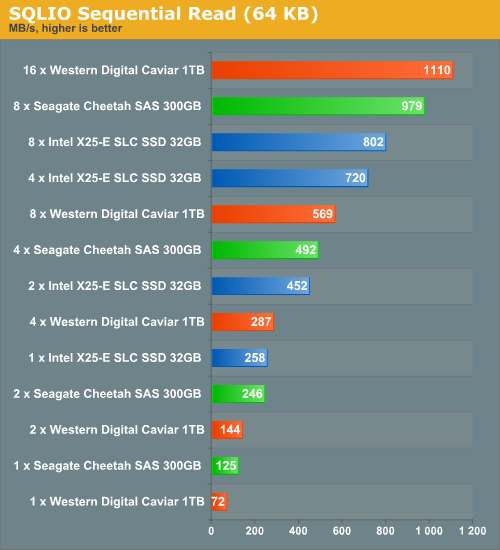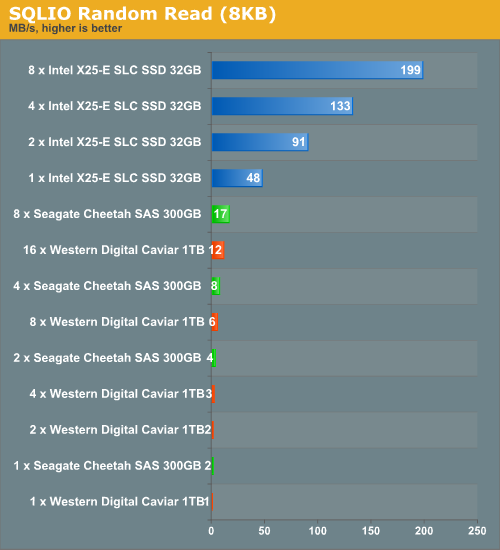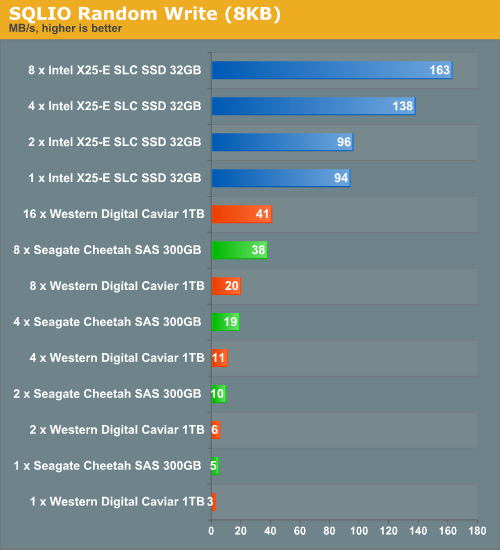SSD versus Enterprise SAS and SATA disks
by Johan De Gelas on March 20, 2009 2:00 AM EST- Posted in
- IT Computing
SQLIO Performance
SQLIO is a tool provided by Microsoft that can determine the I/O capacity of a given disk subsystem. It should simulate somewhat how MS SQL 2000/2005 accesses the disk subsystem. The following tests are all done with RAID 0. We ran tests for as long as 1000 seconds but there was very little difference from our standard 120s testing. Thus, all tests run for 120 seconds.

There are no real surprises here: SQLIO confirms our findings with IOMeter.

Intel promised a 170 MB/s transfer rate when writing sequentially, and our measurements show that the drive is capable of delivering even more. Again, we see a RAID controller limitation pop up when we use eight drives. Let's look at the random read numbers.

While our IOMeter tests showed that the eight SAS drives could come close to a single SLC SSD drive when performing a mix of random reads and writes, this is no longer the case when we perform only random reads. This is clearly the best-case scenario for the SLC drive and it completely crushes any magnetic disk competition.

Random writes are slightly slower than random reads. Still, this kind of performance is nothing short of amazing as this used to be a weak point of SSDs.










67 Comments
View All Comments
shady28 - Sunday, November 15, 2009 - link
I would have really like to see single drive performance of SAS 15K drives vs SSDs. The cost of a SAS controller ($60) + a 15K 150Gig drive ($110-$160) is less than any of the high end SSDs, and about the same as a low end SSD. It's a viable option to get a 15K Drive, but very difficult to see what is the best choice when looking at RAID configs and database IOPs.
newriter27 - Tuesday, May 5, 2009 - link
What was the Queue Depth setting used with IOmeter? Was it maintained consistently?Also, how come no response times?
mikeblas - Friday, April 17, 2009 - link
Intel has posted a firmware upgrade for their SSD drives which tries to address the write leveling problem. The patch improves matters, somewhat, but the overall performance level from the drives is still completely unacceptable for production applications.You can find it here: http://www.intel.com/support/ssdc/index_update.htm">http://www.intel.com/support/ssdc/index_update.htm
Lifted - Sunday, April 12, 2009 - link
I like it!turrican2097 - Monday, March 30, 2009 - link
Please mention or correct this on your article.1) You should mention that the price per GB is 65x higher than the 1TB drives, since you chose to include them.
2) Your WD is a poor performance 5400RPM Green Power drive: http://www.techreport.com/articles.x/16393/8">http://www.techreport.com/articles.x/16393/8
3) If you make such a strong point on how much faster SSDs are than platters, you can't pick the best SSD and then use the hardrives you happen to have laying around the lab. Pick Velociraptors or WD RE3 7200RPM and then Seagate 15K7.
Thank you
mutantmagnet - Monday, April 6, 2009 - link
It's irrelevant. Raptors don't outperform SAS which are better in terms of performance for the GB paid for. There's no need to belittle them when they are clearly aware of the type of point you are making and went beyond it.So far I've found these recent SSD articles to be a fun and worthwhile read; and the comments have been invaluable, even if some people sound a little too aggressive in making their points.
virtualgeek - Friday, March 27, 2009 - link
Just wanted to point this out - we are now shipping these 200GB and 400GB SLC-based STEC drives in EMC Symmetrix, CLARiiON and Celerra. These are the 2nd full generation of EFDs.Gang - this IS the future of performance-oriented storage (not implying it will be EMC-unique - it won't be - everyone will do it - from the high end to the low end) - only a matter of time (we're currently at the point where they are 1/3 the acquisition cost to hit a given IOPS workload - and they have dropped by a factor of 4x in ONE YEAR).
With Intel and Samsung entering to the market full force - the price/performance/capacity curve will continue to accelerate.
ms0815 - Friday, March 27, 2009 - link
Since modern Graphic cards crack passwords more than 10 times faster than a CPU, wouldn't they also be greate Raid Controllers with their massive paralel design?Casper42 - Thursday, March 26, 2009 - link
I would have liked to have seen 2 additional drives tossed into the mix on this one.1) The Intel X25-M - Because I think it would serve as a good middleground between the SAS Drives and the E model. Cheaper/GB but still gets you a much faster Random Read result and I'm sure a slightly faster Random Write as well.
2) 2.5" SAS Drives - Because mainstream servers like HP and Dell seem to be going more and more this direction. I don't know many Fortune 500s using Supermicro. 2.5" SAS goes up to 72GB for 15K and 300GB for 10K currently. Though I am hearing that 144GB 15K models are right around the corner.
Thanks for an interesting article!
MrSAballmer - Thursday, March 26, 2009 - link
SDS with ATA!http://www.youtube.com/watch?v=x4dxTRkODbE">http://www.youtube.com/watch?v=x4dxTRkODbE
http://fakesteveballmer.blogspot.com">http://fakesteveballmer.blogspot.com